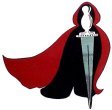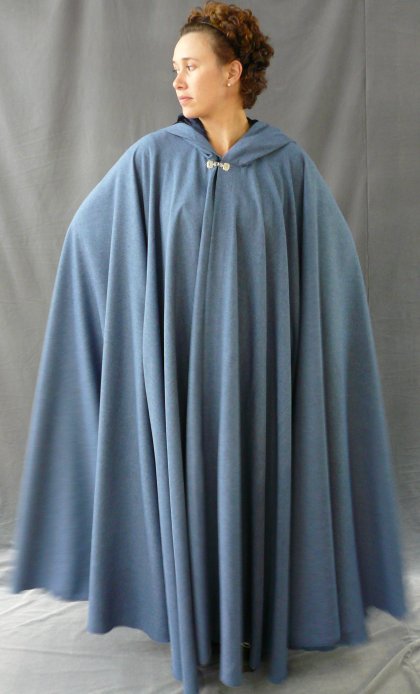

 |
 |
Can you make a ________________ cloak? How much is it going to cost?Making a cloak is not as
simple as sewing a hood to a big ol' piece of
fabric. There are a lot of factors to decide upon before we get started
and it is best for you to have given some thought to those decisions
before
you contact
us. In order for us to give you an estimate the first time you
contact us, try to have some of the following information ready: Is it seriously going to cost THAT
MUCH?! Can't you do it cheaper?!
|
 |
The question of cost relies heavily on the design and specifications
for the individual cloak we are
discussing. We may find ways to cut the cost by substituting
fabricss or
finishings. However there are certain factors like labor and certain
materials that will have a fixed cost no matter what cloak we are
talking
about.
We would say no, but we also suppose that
initially this depends on your definition of "all seasons". There is no
fabric that will be just as comfortable in the Sahara Desert as it will
be in Siberia. The closest we could come is to make a lightweight wool
cloak that would be approriate for the summer, but you would need to
layer your clothing VERY heavily under it during the winter.
There's a pretty good chance we can do that for you. However, when you request a cloak based on a fictional character, please try to include pictures or links to pictures, just in case we aren't familiar with who or what you are talking about. Since we spend a lot of time sewing, taking care of our families and other activities, we're not always pop-culture authorities. However, we have plenty of experience with "Lord of the Rings" and "Star Wars". Please check out our Jedi Robe FAQ for more information.
We don't usually label cloaks as child or adult, since there can be a
progression, with adults wanting a short cloak, or a child insisting on
ground length. So the best way to gauge short cloaks is by the
neck size. Also, labelling a garment as intended for
children calls several very restrictive laws into effect
Other fabrics can be used to make cloaks, as long as they aren't too stretchy. We often use a washable cotton velvet. We can't do a true ¾ circle using velvet because it has a pronounced nap - it is a directional fabric and a ¾ circle involves turning one piece of the fabric relative to the others. We use a more full version of the ½ circle that has pleats over the shoulders, a center back seam and closes over the front. Summer weight cloaks can be made from wide cotton, rayon, linen, or polyester-blend fabric. We've also used specialty fabrics such as water-resistant polyester micro-fiber, and wool/cotton/polyurethane or vinyl raincoat fabric. Full circle cloaks require material that is as wide as the desired back length, generally 50 to 60 inches, or they must be pieced and will require much more fabric. Cloaks with lengths longer than the fabric width may be constructed using additional lengths of fabric, and the additional labor and fabric will increase the cost of the cloak by 30 to 50%.
Full circle cloaks are normally left unlined in the body, but lined in the hood area, partially to improve wearability, and partially due to weight and cost considerations. A full circle cloak does not have shaped shoulders, so the only thing holding it in place is friction. If it is lined with something shiny, the full circle cloak will slide around, and may drag on your neck. We do sometimes line shaped shoulder cloaks, since those are fitted to the shoulders and will stay in place better, but we still discourage a really shiny lining because some slippage will make the cloak difficult to wear during any activity.
A lining made from a fabric different than the cloak will also stretch at a different rate than the outer fabric (generally faster for most linings), which means the only sure way of having the lining not show is to make the lining shorter and unattached to allow room for stretching. Many long coats are lined in this manner. In addition, full lining layer will increase the weight significantly too - rather than a 7 to 10 lb. cloak, you may have a 14 to 20 lb. cloak.
Last but not least, the two layers could generate static electricity in dry winter climates as they slide back and forth
To find the length you will want, decide where you want the
bottom of the cloak to fall (we suggest a floor clearance of at least
6"). Then have a friend measure to this point from the base of your
neck both straight down your back and measure from the center of your
back out over your shoulder to the same distance above the ground.
We'll also need a neck measurement to size it properly.
Two reasons: real life and physics. Firstly, in your real life
you are bound to encounter a variety of nature-induced woes, such as
snow, mud, puddles, and uneven ground. And when your wet/muddy/snowy
cloak starts slapping against the back of your legs and drenches your
pants/dress/etc., you will be frowning. And when you step on your cloak
and trip,
you'll be even more distraught. As for physics, when you have two
parallel lines next to each other, they have the highest apex. As they
start to drift apart, the apex gets lower to the ground. What
does this have to do with my cloak?, you ask. Well, the point is your
legs are the parallel lines and as you walk, your height fluctuates. So
again, the longer the cloak, the more potential there is for you to
trip. And last but not least, the more fabric your cloak is made out
of, the heavier it will be. Cutting 4" off a cloak can change the
weight by a pound or so. So, since we don't want your back to break,
your legs to get wet/muddy/snowy, or for you to trip and fall down
while you're wearing your cloak, we recommend the 6" floor clearance.
We need a deposit to start work, usually ½ depending on the
fabric vs labor costs and your deadline. You can order one piece at a
time and the
backlog for non-rush orders is generally 8-12 weeks. (rush orders are
subject to a surcharge) We take: personal checks, money orders, Paypal, MC,
VISA, AMEX, Discover.
First, we already have custom orders we are currently working on. And
since we want your cloak to be exactly the way you want it, we like to
have the time to send samples to you (via snail mail), and if you don't
like the samples we have on hand, we also want to have the time to
acquire the proper fabrics. However, any given time during the year,
our
schedule may be different, so you can always call us to check.
You will find
some
more helpful information on the Cloaks Custom
Order/Shape info
page and of course you are always welcome to contact
us directly.